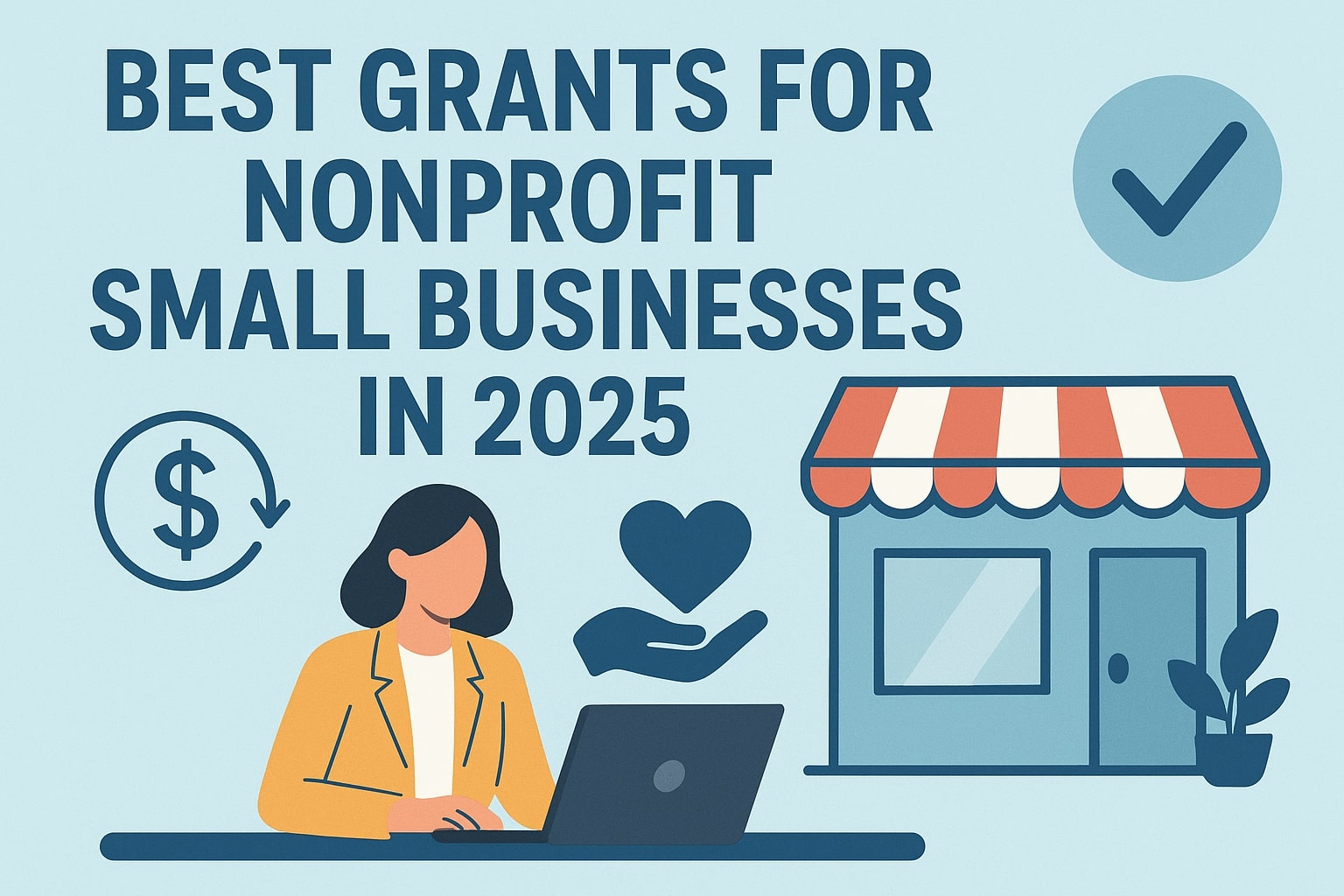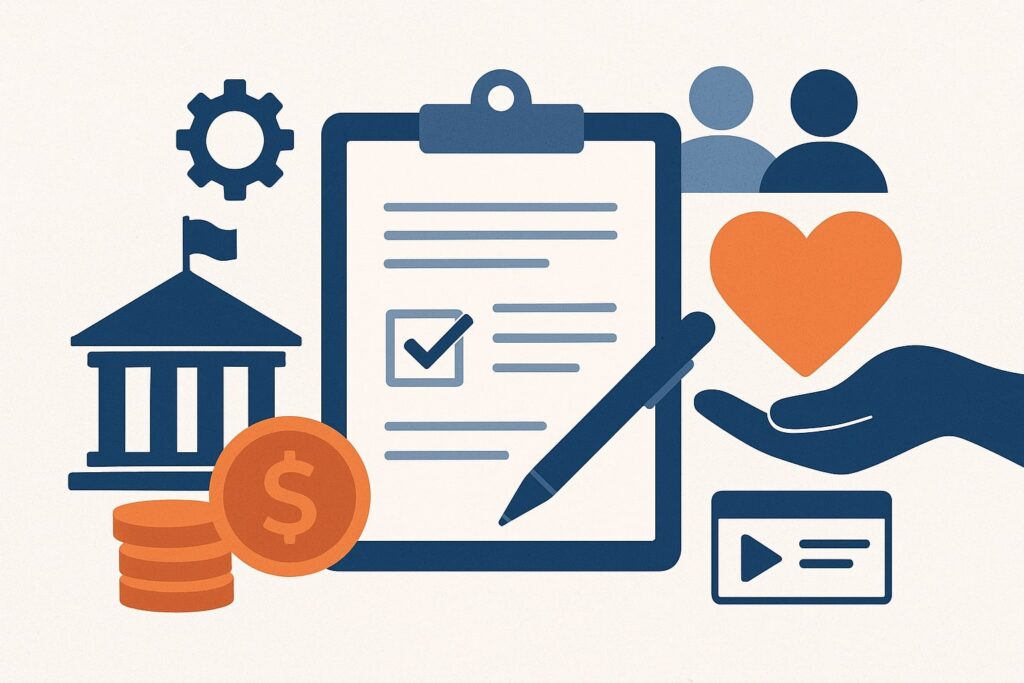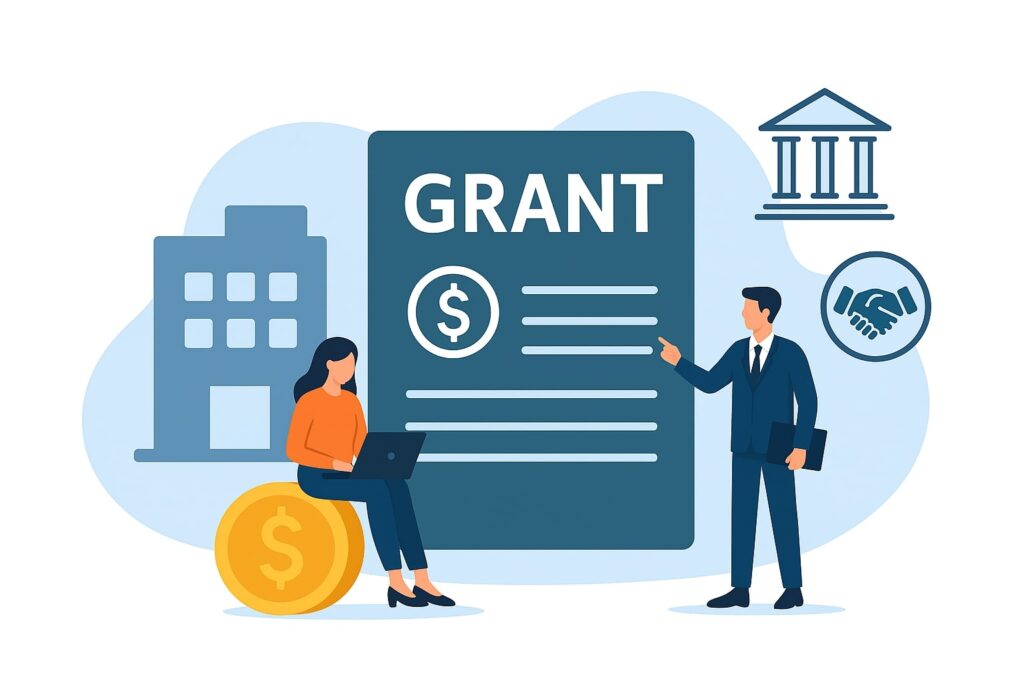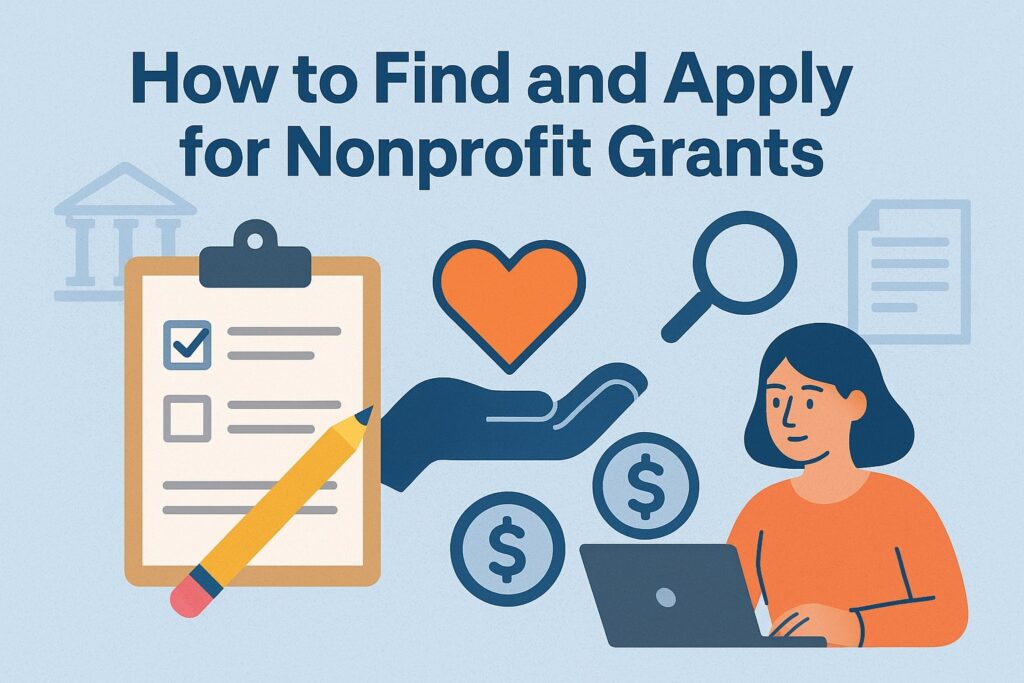
Best Grants for Nonprofit Small Businesses in 2025
Nonprofit organizations – especially small or grassroots “nonprofit small businesses” – often rely on grants to fund their community-impact projects.
In 2025, a wide array of grants for nonprofit organizations is available across federal, state, and private sources, ranging from government programs to corporate philanthropy and local community foundations.
These nonprofit grants can fund everything from general operations to specific projects (arts, education, health, economic development, etc.).
To succeed, nonprofits must align their mission with funder priorities, demonstrate measurable impact, and meet any eligibility requirements (for example, many U.S. grants require 501(c)(3) status).
This guide surveys the major funding avenues for U.S. nonprofits in 2025, with examples of active grant programs, tips on finding opportunities, and links to official sources.
Nonprofits’ funding landscape has evolved in recent years. Funders increasingly seek innovation and measurable results in grantmaking.
For example, many grants now emphasize addressing pressing issues (poverty, education, public health) and require clear outcome reporting. At the same time, new programs have opened up for tech modernization, workforce development, and community-led initiatives.
Whether you represent a small charity, social enterprise, or community organization, the following sections outline top grant categories and specific programs for U.S. nonprofits in 2025.
Government Grants for Nonprofit Organizations

Federal, state, and local governments offer numerous grants that nonprofit small businesses can tap for community development, research, arts, and social services. Many government grants are listed on Grants.gov, the federal database of over 25 agencies’ funding opportunities.
Nonprofits should start by creating an account on Grants.gov to search and apply for relevant federal grants. You can filter by eligibility (e.g. Non-Profit Organization) to find programs open to 501(c)(3) entities.
- Grants.gov – Federal Grant Portal: This is the central hub for U.S. government grants. It includes thousands of grants from agencies like Health & Human Services, Education, Agriculture, and Defense. Nonprofits can browse opportunities, sign up for alerts, and submit applications online.
Using Grants.gov is the first step to access federal funding (such as NIH research grants, Department of Education awards, or community development grants) which can be restricted to nonprofits or social enterprises. The portal even allows filtering specifically for nonprofit applicants. - Formula Grants & Block Grants: Beyond Grants.gov searches, note that some federal funds flow to states or agencies as formula grants, and nonprofits apply through those channels.
For example, Departments of Education and Health distribute block grants to state agencies, which then fund local nonprofit programs.
Nonprofits should check with their state governments for such pass-through opportunities (e.g. state arts councils, housing programs, or community development funds). - National Endowment for the Arts (NEA): The NEA offers arts grants for nonprofits nationwide. Importantly, the Challenge America category supports small organizations: $10,000 grants (with a required local match) to bring arts programs to underserved communities.
This is ideal for small arts nonprofits seeking funding for exhibits, performances, or outreach. The NEA awards roughly 2,300 grants annually across multiple program lines. Details and applications are available on NEA’s website and through Grants.gov. - Economic Development Administration (EDA): The U.S. EDA funds projects that spur local economic growth.
While many EDA grants go to municipalities, nonprofits can partner with eligible entities (or sometimes apply directly) for programs like planning grants, disaster recovery, or business incubators. EDA provides an online Directory of state and city resources to help applicants find opportunities.
For example, EDA’s Economic Adjustment Assistance grants or the Build to Scale program have helped nonprofits create entrepreneurship centers or community broadband plans. Check EDA.gov and state EDA offices for current calls. - U.S. Small Business Administration (SBA): Contrary to small-business loans, the SBA does offer grants – but mainly to nonprofits and support organizations, not to start or expand for-profit businesses.
The SBA administers programs that fund entrepreneurial training and resource partners. For example, the SBA PRIME (Program for Investors in Microentrepreneurs) grant provides funding to nonprofit microenterprise development organizations (often small nonprofits that train or loan funds to disadvantaged entrepreneurs).
These awards (often up to tens of thousands of dollars) help build nonprofit capacity or deliver small-business technical assistance.
Similarly, SBA awards cooperative agreements for Veterans Business Outreach Centers, SCORE, and Small Business Development Centers – all of which are nonprofits or public entities that promote entrepreneurship.
(Keep an eye on Grants.gov in spring, since PRIME announcements typically post around April/May.) - Disaster and Community Grants: In recent years, special funds have become available for community resilience (e.g. COVID relief, infrastructure, climate adaptation). Nonprofits should watch for announcements from FEMA, the Department of Interior, and state emergency offices.
For example, historic federal infrastructure bills have created funding for community broadband or clean water projects that nonprofits can apply to in partnership with local governments.
Major Corporate and Foundation Grants

Many large companies and private foundations run grant programs aimed at nonprofits. These can range from modest “microgrants” to multi-year awards of hundreds of thousands. The priorities vary (education, health, environment, social services, etc.), but all are worth exploring. Below are examples of high-profile opportunities in 2025:
- Walmart Foundation Local Community Grants: Each quarter, Walmart and Sam’s Club locations in the U.S. award community grants ($250–$5,000) to local nonprofits for projects aligned with focus areas like education, workforce development, and hunger relief.
The Walmart Foundation portal (via CyberGrants) opens annually (typically in spring) for nonprofits to apply in one of eight areas.
Eligibility is generally 501(c)(3) groups with W-9s for recipients; applications start with a brief questionnaire and then a full submission if eligible. These small grants can fund events, equipment, or program supplies for community projects. - Bank of America Charitable Foundation – Neighborhood Builders®: Bank of America’s flagship program is Neighborhood Builders®. It awards participating nonprofits $20,000 grants plus intensive leadership training for key staff and board members.
Since 2004, Bank of America has invested millions in thousands of U.S. nonprofits through this program. In 2025, the Neighborhood Builders® application is open from May 1 to June 1 to eligible 501(c)(3) organizations focusing on community needs (applicants take an eligibility quiz on BoA’s site).
Winners join a multi-year national network of nonprofit leaders and also receive possible follow-on grants. (See Bank of America’s Grant Funding page for full criteria and deadlines.) - Google Ad Grants: Through the Google for Nonprofits program, any qualifying 501(c)(3) can receive up to $10,000 per month in free Google Search ad credits.
This is not cash funding, but it’s an extremely valuable resource: eligible nonprofits can run Google Ads campaigns to recruit donors, volunteers, or promote programs, without budget.
Importantly, this is non-competitive – every nonprofit that meets Google’s criteria can get the grant. (Google requires an active Google for Nonprofits account and adherence to its ad policies.) This “grant” effectively provides significant marketing reach at no cost. - Amazon Web Services (AWS) Imagine Grant: AWS offers a major technology grant to nonprofits striving to modernize their operations. In 2025, the Imagine Grant is awarding three tiers of grants for U.S. nonprofits (all 501(c)(3)) incorporating cloud and AI solutions.
The top tier, the Pathfinder (Generative AI) award, provides up to $200,000 USD in unrestricted cash plus $100,000 in AWS credits and technical support.
Lower tiers (Go Further, Faster and Momentum to Modernize) offer smaller packages (e.g. $150,000 + $100k credits; $50,000 + $20k credits).
While the 2025 cycle is closed, nonprofits can register for updates on the AWS site and prepare to apply when it reopens (typically announced late year).
Past recipients include charities developing AI tools for conservation or health. This grant is ideal for nonprofits with tech-driven projects in AI, data, or cloud-based services. - Other Corporate and Tech Grants: Many companies offer nonprofit grants or in-kind support. For example, the Microsoft Tech for Social Impact and Adobe Creativity Grants (for non-profit use of their software), or Salesforce Pro Bono Grants.
In general, large tech firms (Google, Amazon, Microsoft, Cisco, etc.) periodically announce grants or donations (some via their philanthropic arms) to support education, veterans, digital access, or nonprofits adapting technology.
(See Google.org, Amazon Web Services Nonprofit, and company CSR pages for current programs.) In 2025, it’s wise for nonprofits to monitor announcements by Google, Amazon, Apple, and other industry leaders, as major new grant competitions sometimes launch yearly. - Private Foundations: Numerous private foundations issue grants to nonprofits in areas like health, education, youth, and social justice.
For example, the Harry and Jeanette Weinberg Foundation (a large national funder) supports organizations addressing housing, health, jobs, education, and aging, especially for low-income populations.
Weinberg has a special Small Grants program for growing nonprofits – eligibility includes 501(c)(3) status, serving vulnerable populations, and having audited financials.
Similarly, family foundations like W.K. Kellogg, Ford Foundation, Carnegie Corporation, and Robert Wood Johnson Foundation each have open application cycles (usually on their own websites) for projects in their focus areas (children and families, racial justice, democracy, health equity, etc.).
These programs often require a letter of inquiry followed by a full proposal. While competition is stiff, these funds can be substantial. Nonprofits should consult the foundations’ official sites for 2025 deadlines and guidelines. - Micro-Grant Foundations: A few organizations specialize in very small, fast-turnaround grants to grassroots projects.
For example, The Pollination Project awards 365 seed grants of $1,000 each year to nonprofits or initiatives (worldwide) that are just starting out. Their daily application process is open to any project with a strong community-focus and social mission.
Likewise, the Awesome Foundation disburses $1,000 “micro-grants” via local chapters, with an extremely simple application (three questions).
These are good options for ultra-small nonprofits or pilot projects needing modest funding and minimal paperwork. (Search “Pollination Project grants” and “Awesome Foundation grants” for application links.) - Matching and Sponsorships: Some corporate programs operate as challenge or matching grants. For instance, Google’s Ad Grant requires nonprofits to maintain active digital engagement (e.g., matching 5% click-through rates) but then provides funds.
Similarly, local businesses or regional chapters (e.g. Rotary Clubs, community Banks) often sponsor nonprofits through matching programs or awards.
For example, Bank of America employees and retirees can earn volunteer grants (typically $1,000) for nonprofits they serve. (This is an in-kind grant tied to volunteer hours, but is effectively free funding if your organization engages corporate volunteers.)
Community Foundations and Local Grants

Local funding sources are often overlooked but can be very fruitful for small nonprofits. Community Foundations – philanthropic organizations focused on a city or region – distribute grants aligned with local needs.
These public charities pool donations from individuals, families, businesses, and government, and then support local nonprofits.
- Regional Community Foundations: Every state has one or more large community foundations. For example, the Silicon Valley Community Foundation (California), Foundation for the Carolinas (North Carolina), The Chicago Community Trust (Illinois), The Columbus Foundation (Ohio), and many others are among the top U.S. grantmakers.
These organizations fund a wide range of local initiatives (education, housing, arts, health, etc.), often with grants specifically earmarked for “small” or grassroots nonprofits. Community foundations typically issue Requests for Proposals (RFPs) several times a year in categories like youth development, economic stability, or environmental projects.
Because their mission is tied to a locality, these grants can be less competitive for small regional organizations than national grants. Nonprofits should research the community foundation covering their area (e.g., “Community Foundation of [City/County]”) and review its giving priorities. - State and City Grants: Many U.S. states and cities have grant programs for community nonprofits. For example, a state’s Office of Economic Development might offer “Downtown Revitalization” grants to nonprofits working on community planning.
City cultural affairs offices often fund local arts nonprofits. Nonprofits should check state government websites (e.g. grants directories at grants.gov/state or specific state portals) and local city/county grant listings.
Tools like GrantWatch or Foundation Directory (both subscription-based) can also help find region-specific grants for local nonprofits. - Public-Private Partnerships: Some local initiatives involve public grant matching. For instance, a city may launch a competition for neighborhood nonprofits with business partnership support, or a municipal fund (like Seattle’s civic grants) may allocate funding to local charities. Monitoring local government RFP sites and signing up for city/county nonprofit news can uncover these opportunities.
How to Find and Apply for Nonprofit Grants

Locating and securing grants requires strategy. Here are some practical tips:
- Use Grant Databases and Search Engines: Start with federal sources like Grants.gov. For foundations and corporate grants, tools like GrantWatch (a paid directory with thousands of listings) and Philanthropy News Digest (free RFP listings) can help.
Many libraries offer access to the Foundation Directory Online (by Candid) for nonprofit grant research. Local nonprofit networks and listservs often announce grant RFPs. - Align with Funder Priorities: Carefully read each grant’s purpose. Tailor your proposal to match the funder’s stated goals.
As one expert notes, organizations must “articulate a clear vision” and show how their work “aligns with funder priorities” using concrete data and stories.
Include metrics (e.g. number of clients served, outcomes achieved) to demonstrate impact. This data-driven storytelling can distinguish your application. - Meet All Requirements: Ensure you qualify before investing time. Common eligibility criteria include IRS 501(c)(3) status, geographic location, and population served (e.g. low-income, veterans, youth, etc.).
Keep updated 501(c)(3) documentation, audited financials, and a DUNS number (if needed for federal grants). For example, the Weinberg Foundation explicitly requires nonprofits to provide audited statements and serve low-income populations. - Leverage Local Resources: Small nonprofits can often get free help from organizations like U.S. Small Business Development Centers (which serve nonprofits), SCORE mentors, or local foundations.
They may offer grant-writing workshops or one-on-one consultations. Building relationships with program officers (by phone or at nonprofit conferences) can also provide insights on upcoming grants. - Pay Attention to Deadlines: Many grants have strict annual cycles. For instance, Walmart’s quarterly grant cycles open in the spring, Bank of America’s open February–March, and AWS cycles are once per year.
Mark your calendar and prepare materials (proposal narratives, budgets) well in advance. Some grants (like Challenge America or Neighborhood Builders) are offered only once yearly. - Be Proactive with Microgrants: Don’t overlook quick-turnaround opportunities. Foundations like the Awesome Foundation or YSEALI grants (for Southeast Asia) award modest sums with rolling applications.
These can provide “seed” funding to get a project off the ground, which you can then leverage for larger grants.
Examples of Active Grant Programs
Below are some notable grant programs and sources available to U.S. nonprofits in 2025 (check each link for up-to-date application info):
- Grants.gov (Federal Grants Portal): Thousands of federal grants; filter for “Non-Profit Organization” eligibility. Includes federal agency programs in health, environment, education, etc.
- NEA Challenge America: $10,000 grants (match required) for small or underserved arts nonprofits.
- Economic Development Administration (EDA): Funds for local economic/innovation projects (search state listings).
- Walmart Local Community Grants: $250–$5,000 each quarter for 501(c)(3) community projects.
- Bank of America Neighborhood Builders: $20k grants + leadership training (open May 1–June 1, 2025 to eligible nonprofits).
- Google Ad Grants: Up to $10k/month in free ads for eligible 501(c)(3)s (through Google for Nonprofits).
- AWS Imagine Grant: Major tech grants (up to $200k + credits) for U.S. nonprofits doing cloud/AI projects.
- Pollination Project Grants: $1,000 seed grants (365 annually) for nonprofit social-change projects.
- Awesome Foundation Microgrants: $1,000 grants by volunteer chapters for innovative community projects.
- Community Foundation Grants: Regional foundations (e.g., Silicon Valley Community Foundation, Chicago Community Trust) offer local project grants.
- SBA PRIME Grant: Competitive grants for nonprofit microenterprise development organizations.
Frequently Asked Questions
Q: Who qualifies as a “nonprofit small business” for these grants?
A: In U.S. grant contexts, “nonprofit” usually means a 501(c)(3) organization (or equivalent in public/government entities). The term “small” might refer to the organization’s budget size or scale of operations, but legally the primary qualifier is the tax-exempt status.
Some grants also require nonprofits to have been in operation for a certain period (often 2–3 years) and to serve certain populations (e.g. low-income communities).
Always check the grant’s specific eligibility – some programs (like SBA grants) explicitly exclude for-profit businesses, while others allow both non-profits and for-profit social enterprises.
Q: How can a nonprofit find grant opportunities?
A: Use a combination of resources. Grants.gov is key for federal funding. For corporate/foundation grants, search engines and directories like GrantWatch, Philanthropy News Digest, or state grant portals help.
Networking with local nonprofits, attending workshops, and subscribing to newsletters of major funders can alert you to new grants. Many community foundations post RFPs online. Also consider tools like Grants.gov blog for tips and Foundation Directory (often via libraries).
Q: Do I need a formal proposal to apply?
A: Yes. Most grants require a written proposal outlining your project, budget, and organizational details. Some may start with a short letter of inquiry (LOI) or eligibility form, followed by a full application if invited.
Even for microgrants (e.g. Pollination, Awesome), you’ll fill an application form. Be prepared to articulate your mission, activities, and impact metrics. Many nonprofits benefit from templates or grant-writing guides. Remember to highlight how the grant will help you achieve measurable outcomes aligned with the funder’s goals.
Q: Are grant funds taxable?
A: Generally, grants awarded to 501(c)(3) nonprofits for charitable activities are not taxable income (they are considered contributions, not business revenue).
However, grants for sponsorship or naming rights can sometimes have tax implications. Consult a nonprofit accountant for specifics, especially on federal grants which often have strict reporting requirements.
Q: What makes a competitive nonprofit grant application?
A: Strong alignment and clarity. Funders look for programs that directly address their priorities and that can demonstrate clear impact. Use data and real examples: e.g., “Last year our literacy program led 80% of participants to improve reading scores” rather than vague promises.
Also show organizational capacity (staff expertise, fiscal health). Many funders appreciate evidence of community support (matching funds, volunteer hours).
Following guidelines exactly (format, word limits) is crucial. Don’t hesitate to reach out to program officers with clarifying questions before applying.
Q: Can small nonprofits realistically win these grants?
A: Absolutely. In fact, many grants are designed for smaller organizations. For instance, NEA’s Challenge America and various corporate grants explicitly target small nonprofits.
Foundations like the Pollination Project and Awesome Foundation exist solely to seed emerging groups. Community foundations inherently focus on local, often small-scale, groups.
The key is to match your nonprofit’s mission and size with the right funders, and to tell your story in a compelling, data-backed way.
Conclusion
In 2025, nonprofit small businesses in the U.S. have an encouraging array of grant opportunities. Federal programs (via Grants.gov, EDA, NEA, SBA, etc.) coexist with corporate philanthropy (like Walmart, Bank of America, Google, Amazon) and private foundations (from local community trusts to national giants).
Each source has its own focus and cycle, but collectively they cover almost every sector of nonprofit work.
Successful grantseeking hinges on research and preparation: non-profits should identify funders whose priorities match their mission, comply with all requirements (tax status, reporting), and craft applications that highlight their impact.
By leveraging databases and local networks, staying alert to deadlines, and adopting data-driven proposals, even the smallest nonprofit can tap these funding streams.
The grants outlined here represent just a sample of the support available. As one guide notes, foundation grants alone number in the thousands and often have simpler application processes than government grants.
Meanwhile, government portals like Grants.gov aggregate hundreds of federal opportunities. In short, with diligence and alignment, nonprofit small businesses can secure significant grants to expand their work in 2025.